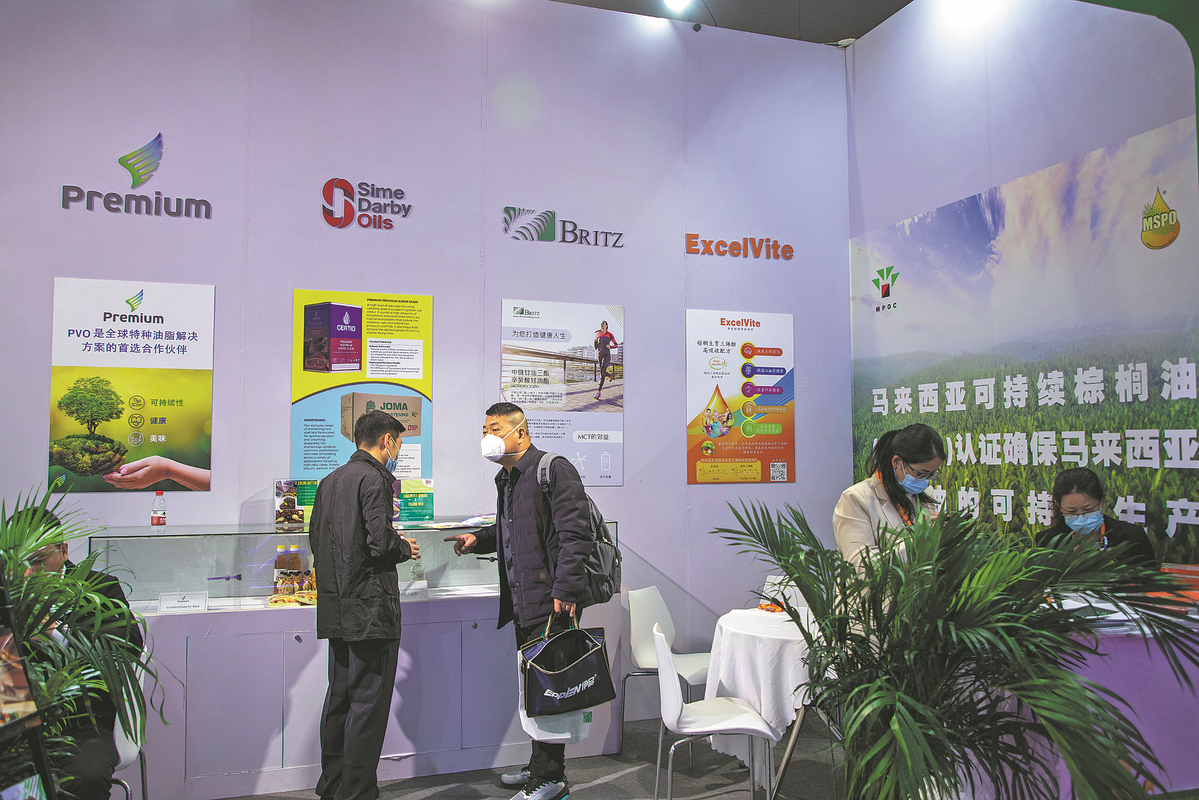Efforts made to make supply chains greener
Source:China Daily Release time:2024/11/25
 Malaysian palm oil manufacturers promote sustainable production at Food Ingredients China 2023, an international exhibition for food ingredients and additives, in Shanghai in March last year. Provided to CHINA DAILY
Malaysian palm oil manufacturers promote sustainable production at Food Ingredients China 2023, an international exhibition for food ingredients and additives, in Shanghai in March last year. Provided to CHINA DAILY
As China progresses with its aim to achieve carbon neutrality before 2060, the nation has adopted policies and initiatives to promote green supply chains in order to drive down emissions among micro, small and medium-sized enterprises.
Green supply chains integrate eco-friendly practices in sourcing, production and distribution to minimize environmental impact, enhance sustainability and promote resource efficiency throughout the entire supply process.
Despite notable advancements in this area, experts have highlighted that China still faces numerous challenges in establishing globally recognized standards and certification systems for green supply chains.
Stressing the importance of the disclosure of carbon emission information in fostering green supply chains, they maintain that China's extensive experience in its successful air pollution control initiatives, where information disclosure played a crucial role, offers valuable insights for the government on advancing in this direction.
Tang Dingding, former director general of the department of international cooperation of the now-defunct ministry of environmental protection, noted the great importance China's central authorities have attached to green supply chains, despite the concept only being recently introduced to China.
In 2013, the ministry of environmental protection became the Ministry of Ecology and Environment. The new ministry is responsible for the environment and six government bodies, including those tackling climate change.
In 2010, Tang participated in the former ministry's first international cooperation on green supply chains, and recently shared the experience at an event focused on green supply chains in Beijing.
Led by him, a team consisting of members from home and abroad conducted a study program with the China Council for International Cooperation on Environment and Development, an international think tank that reports to the Chinese government, he shared.
He said that green supply chains have been explicitly incorporated into the guiding documents of both the Communist Party of China Central Committee and the State Council, as demonstrated by a set of guidelines they jointly unveiled in August to ramp up the green transition in all areas of socioeconomic development.
According to the document, China will encourage businesses to engage in green procurement practices and establish eco-friendly supply chains, fostering a synergistic transformation throughout both upstream and downstream sectors, as it strives to establish a green, low-carbon and circular development economic system by 2035.
"The supply chain concept can act as a vital catalyst in propelling China's shift toward green, low-carbon practices and efforts to promote actions to cope with climate change," he said.
Mao Tao, an official from the Ministry of Industry and Information Technology's Center for International Economic and Technological Cooperation, said the Chinese government's high regard for the construction of green supply chains was also reflected at the Central Economic Work Conference held late last year in Beijing.
A statement released after the conference said China will accelerate the development of a green and low-carbon supply chain as it actively and steadily advances its climate targets of peaking carbon dioxide emissions before 2030 and realizing carbon neutrality before 2060.
Currently in China, many environmental protection efforts are being driven by government action. The construction of green supply chains, however, represents voluntary environmental initiatives by businesses, Mao noted.
"Green supply chains emphasize synergy between upstream and downstream sectors, and serve as a valuable complement to government efforts in energy conservation and carbon reduction," he said.
He emphasized the role of green supply chains in pushing for contributions from micro, small and medium-sized enterprises, the number of which stands at more than 52 million, to reduce their carbon emissions.
These small and medium-sized enterprises have relatively low greenhouse gas emissions, however, they fall short of large enterprises in financial strength, technological expertise and management capabilities, and demonstrate a lesser degree of environmental awareness, he said.
"This underscores the need for collaborative initiatives from upstream enterprises to propel them toward emission reduction."
Mao said there is an overall inadequate performance among Chinese companies in developing green supply chains, despite the pioneering efforts of industry heavyweights such as e-commerce company JD, telecoms provider Huawei, photovoltaic manufacturer LONGi, and Lenovo, the world's largest personal computer maker by shipments.
There is a pressing requirement for the nation to enhance its pertinent policy and legal frameworks, he said, stressing the crucial necessity of establishing a foundational database to support the development of sustainable green supply chains.
He highlighted the notable challenges faced by the country's photovoltaic sector, which boasts manufacturing capacity and market size surpassing that of any other country worldwide.
Although China boasts strength in the field, it faces significant barriers when exporting its PV products due to the lack of recognition for the standards and certifications of these products by certain countries, Mao said.
He said the Ministry of Industry and Information Technology is actively promoting the development of a footprint database for industries that provide key raw materials used in PV manufacturing, as part of its efforts to lay the groundwork for addressing the issue.
It's also imperative to further enhance information disclosure in China, as the country progresses with the development of green supply chains, he said. While some policies are already in place to encourage information disclosure in large enterprises, there remains significant room for improvement in the performance of small and medium-sized companies.
He proposed that alongside tailored policies, harnessing the power of industry front-runners to drive information disclosure among small and medium-sized enterprises in their upstream could be another effective strategy.
Yang Pingjian, a researcher at the Chinese Research Academy of Environmental Sciences, said that information disclosure has played an indispensable role in the sweeping, historic and transformative changes witnessed in the realm of environmental protection in China, particularly in the domain of air pollution.
"Information disclosure enables the public to be informed and empowers people to better provide oversight. Its role as a long-lasting mechanism to drive actions along the entire chain has been fully demonstrated in China's experiences in pollution control over the past decade," he said.
Yang stressed that the government has sent a very clear signal that it expects enterprises to disclose carbon emission information as much as possible and in as much detail as possible.
Outlining efforts at national and regional levels for establishing green supply chains, Chai Qimin, director of the department of the strategy and planning at the National Center for Climate Change Strategy and International Cooperation, expects promising outcomes from China's efforts in this regard in promoting low-carbon transition.
Quoting a report from the World Economic Forum, he said the supply chains of food, construction, fashion, fast-moving consumer goods, electronics, automotive, professional services and freight account for more than half of all global greenhouse gas emissions.
Globally, optimizing the entire industry chain and supply chain for comprehensive and systematic management to advance carbon reduction has become a significant focus, he said. In this context, over 20 countries and regions worldwide have implemented institutions aimed at managing industry chains and product footprints.
In China, the Ministry of Ecology and Environment, in cooperation with 14 other national government bodies, announced a comprehensive plan on carbon footprint management in May, which aims to establish calculation rules and standards for approximately 100 key products by 2027, Chai said.
As part of a broader strategy outlined by the plan, the ministry published a standard with general principles for product carbon footprint calculation in September, which is expected to offer clear guidelines in the development of specific standards to calculate carbon emissions for different products.
Shandong and Guangdong provinces have been at the forefront of promoting such initiatives related to green supply chains, with each of them releasing plans for managing carbon footprints and implementing labeling practices, he said.
In other areas such as Zhejiang and Jiangsu provinces and Shanghai, as well as in some industrial sectors, including electronics and electrical appliances and petrochemicals, there have also been efforts made to explore similar initiatives, he said.
Chai stressed the work is highly complicated, as there are a large number of emissions sources in the supply chains of some industrial sectors. The number of sources for PV products, for instance, may go beyond 1,000.
Despite the challenges, he said there has been a general trend toward comprehensive emissions disclosure for companies and products in China, underpinned by a transition from voluntary measures to mandatory ones.
"I believe that, driven by various incentives and regulatory policies, the green and low-carbon transformation of supply chains in China will achieve more substantial results," Chai said.








